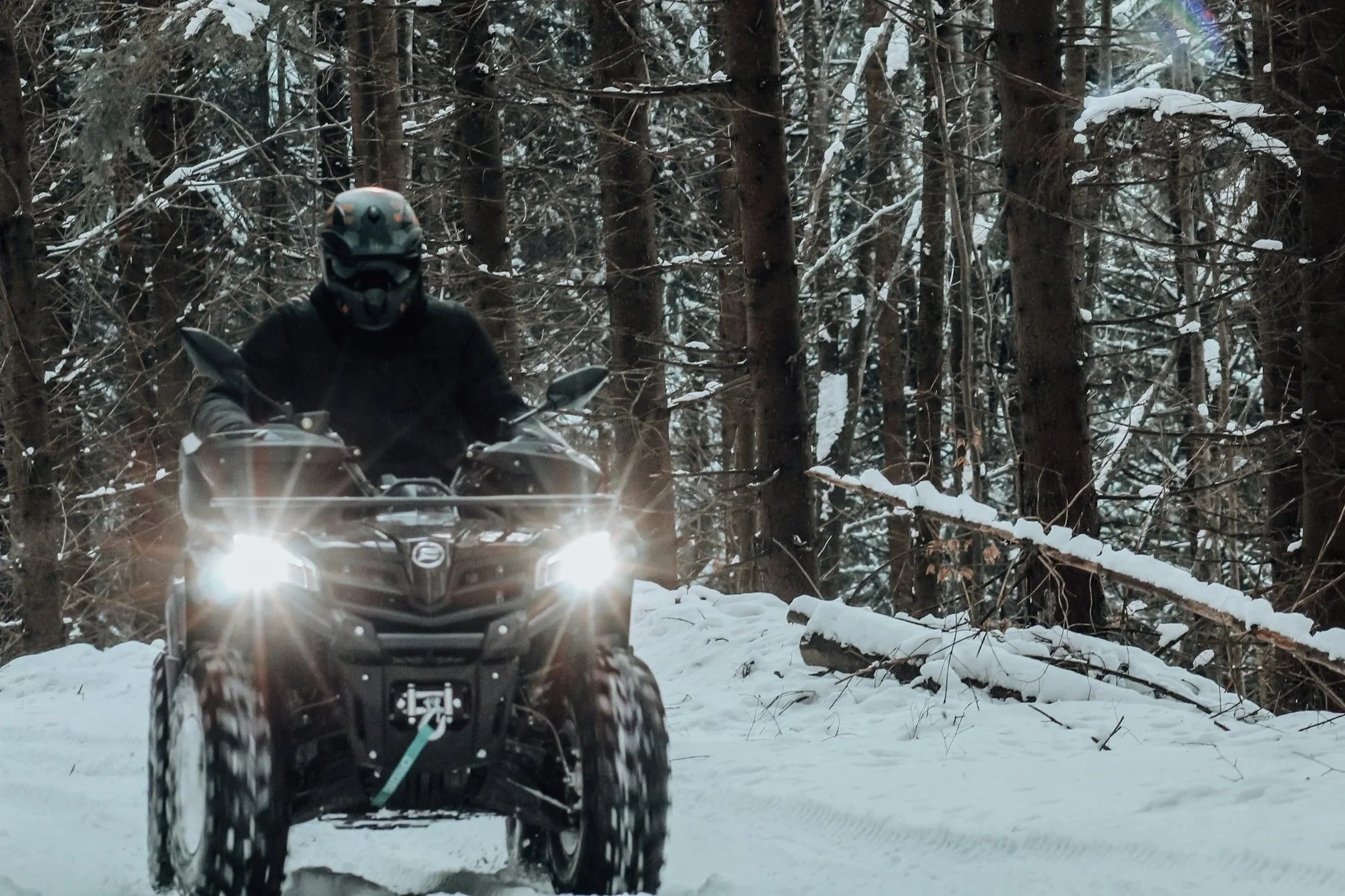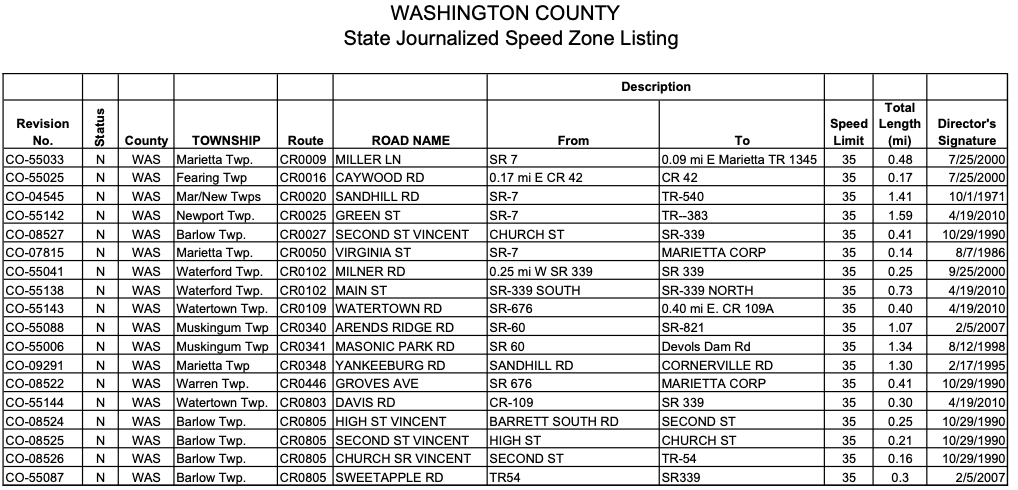
APV/UTV Information
A Guide to APVs and UTVs in Washington County, Ohio
All-purpose vehicles and Utility Vehicles—categories of recreational and work vehicles that, under Ohio law, include All-Terrain Vehicles (ATVs) and Side-by-Sides (SxSs)—may now be legally driven on certain Washington County and township roads.
It is the responsibility of the APV/UTV owner to understand and abide by the rules and know which specific townships permit legal APV/UTV usage.
It remains illegal to drive these vehicles on all state highways and interstate roads, as well as roads in municipalities and townships that have not taken action to legalize the road use of these types of vehicles.
Video of Sheriff Warden and Chief Lockhart describing the new laws pertaining to off-road vehicles on County Roads.
WHAT VEHICLES ARE COVERED?
The first step to legal operation of “All Purpose” (APV) and “Utility” (UTV) vehicles is to determine how your vehicle is classified. As a general rule, more restrictions apply to the legal operation of UTVs than apply to the legal operation of APVs, so it is important to be aware of the distinctions.
All-Purpose Vehicle (APV): Any self-propelled vehicle designed primarily for cross-country travel on land and water, or any combination of thereof, including vehicles that operate on a cushion of air, vehicles commonly known as all-terrain vehicles, all-season vehicles, mini-bikes, and trail bikes.
Utility vehicle (UTV): A self-propelled vehicle designed with a bed, principally for the purpose of transporting material or cargo in connection with construction, agricultural, forestry, grounds maintenance, law and garden, materials handling, or similar activities.
Under these definitions, a recreational vehicle without a bed or cargo area such as an All-Terrain Vehicle is classified and will be registered as an All-Purpose Vehicle (APV). That classification will also be reflected on the vehicle’s title. Registered APVs have smaller license plates than UTV.
A vehicle with a bed or cargo area (such as certain side-by-sides) may be classified and registered as either “APV” or “UTV”, so check your vehicle title to determine whether your vehicle with a bed is titled as an APV or a UTV.
ON WHAT ROADS IN WASHINGTON COUNTY CAN I DRIVE MY APV OR UTV?
By default, the operation of APVs and UTVs on roads and highways in Ohio is illegal. Unless a local jurisdiction has adopted a resolution allowing the operation of these classes of vehicles on the roads and highways under its control, operation remains illegal. Please see the Washington County Commissioners’ resolution that allows certain APV/UTV operations.
APV operation is allowed on roads and highways under the jurisdiction of Washington County and certain local townships, provided all legal requirements applicable to that class of vehicles are followed.
UTV operation is allowed on Washington County roads with an established speed limit of 35 MPH or less, but is prohibited on any road or highway with a speed limit greater than 35 MPH. As with APVs, compliance with UTV legal requirements is necessary for roadway operation of these vehicles to be legal. (See maps at the bottom of this page)
In Ohio, roads without posted speed limits have a default speed limit of 55 MPH. UTV operation on unposted roads remains illegal, but APV operation is allowed.
The State of Ohio and the Federal Government prohibit the use of APVs and UTVs on state roads and interstate highways. Therefore, APVs and UTVs are prohibited on state routes and interstate highways that run through Washington County.
IS IT LEGAL FOR JUST ANYONE TO DRIVE ANY APV OR UTV ON THE ROAD?
NO. To drive an APV or UTV legally on the road, you must:
Be a licensed driver
Operate a roadworthy APV or UTV that is registered with the BMV
Ensure that an appropriate insurance policy covers your APV or UTV.
Note: While it is impossible to register a UTV unless it has first been inspected by law enforcement, APVs are not required to undergo inspection.
Additionally, you may only drive your APV or UTV on the road if it meets or exceeds the minimal equipment requirements under Ohio law that apply to its class of vehicle. Greater equipment requirements apply to UTVs than APVs. The inspection requirement for UTVs will ensure that your UTV is fully equipped with the necessary equipment.
Here is a simplified comparison of what is required to drive these classes of vehicle on roads where it is allowed:
APVs:
Licensed Driver Required
Insurance Required
Registration and Plates Required
Required Equipment: one headlight and one taillight (if driven at night), adequate brakes, and a muffler
No Inspection Required
No Restriction on Roads under County Jurisdiction or under the Jurisdiction of Townships that Allow
UTVs:
Licensed Driver Required
Insurance Required
Registration and Plates Required
Required Equipment: brakes, lights, turn signals, steering, horn, glass, mirrors, exhaust system, windshield wipers, tires must pass inspection.
An inspection is required before registration. The vehicle owner must find the VIN number on their vehicle, prior to calling for an inspection, and show it to the Deputy conducting the inspection.
Limited to County Roads 35 MPH or Under. See the Sheriff's Office UTV map below for reference.
Golf Carts:
Licensed Driver Required
Insurance Required
Registration and Plates Required
Required Equipment: brakes, lights, turn signals, steering, horn, glass, mirrors, exhaust system, windshield wipers, tires must pass inspection.
An inspection is required before registration. The vehicle owner must find the VIN number on their vehicle, prior to calling for an inspection, and show it to the Deputy conducting the inspection.
Limited to specific townships that have adopted resolutions. See below
UTV/Golf cart Inspection Information
Before an inspection of a UTV/golf cart, the owner must find the VIN number of their UTV/golf cart and show it to the Deputy conducting the inspection.
If you have a UTV/Golf cart that needs to be inspected, please call 740-376-7070 ext. 0
If you have questions about the legalities of APV/UTV/ Golf carts, please review the above information carefully. (Do not call 9-1-1)
You may also send an email to info@wcso84.us
This interactive map shows the areas where UTV off-road vehicles are permitted, provided other requirements are met. This map can also be found here: Sheriff’s Office UTV Map
(Click “Sheriff’s Office UTV Map”)
Best viewed on a computer.)
How to use the map:
Use the “+” and “-” buttons to zoom in and out. Use your mouse to drag the map around. 35 mph zones are marked with white and black lines.
The table below is the Speed Zone Listings. This table lists all 35 MPH zone county roads on which UTVs can be operated. It is the same as the Sheriff’s Office UTV Map. There are details about the location, road name, and distance of the 35 mph sections. You can download this table here: Speed Zone Listings
Townships that have allowed APV access
The following is a list of townships which have adopted APV resolutions that allow for operation of APV’s anywhere in the township excluding interstate highways, state routes, and within muncipalities which have not adopted any APV resolution.
Muskingum Township.
Townships that have allowed golf cart access
The following is a list of townships which have adopted golf cart resolutions that allow for operation of golf carts in the township excluding interstate highways, state routes, and within muncipalities which have not adopted any golf cart resolution.
Muskingum Township: Limited to any road marked 25 mph or less.

